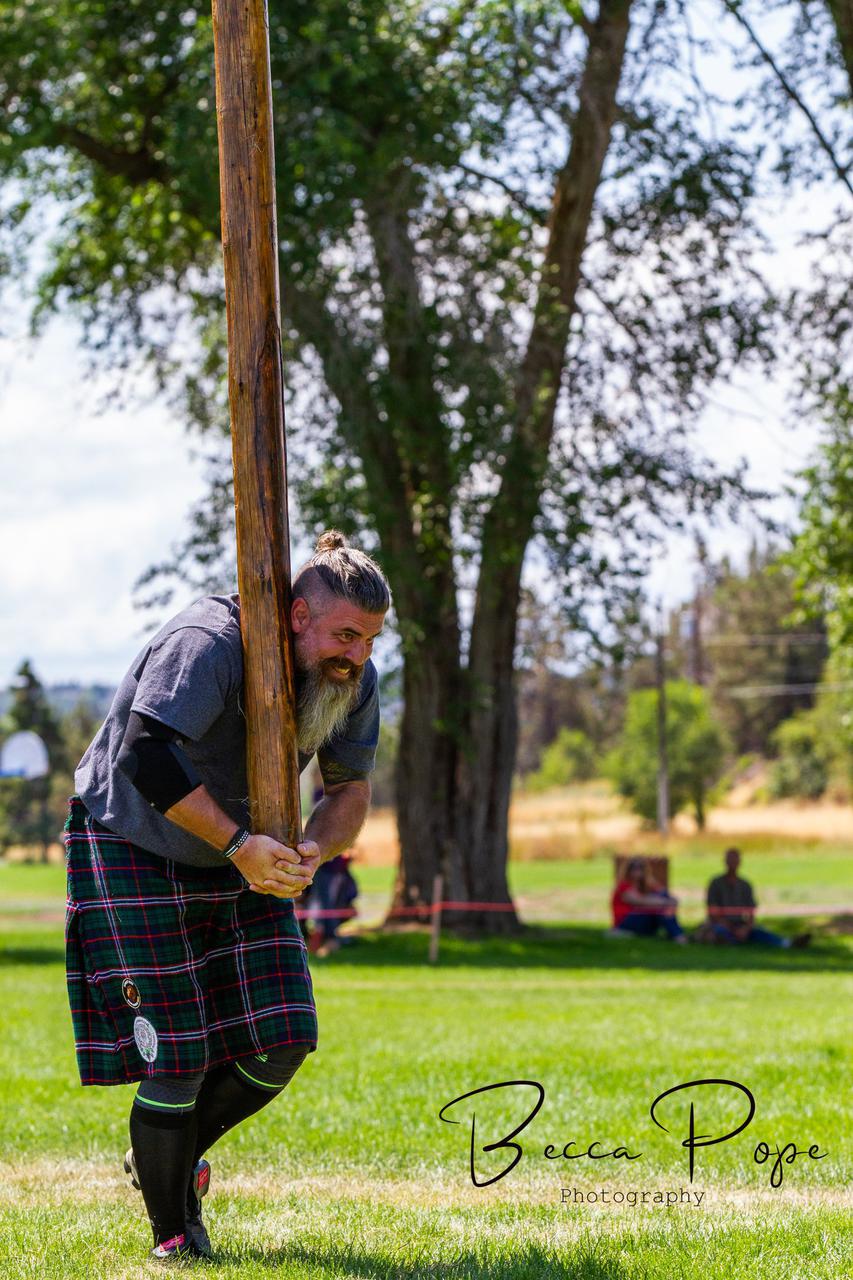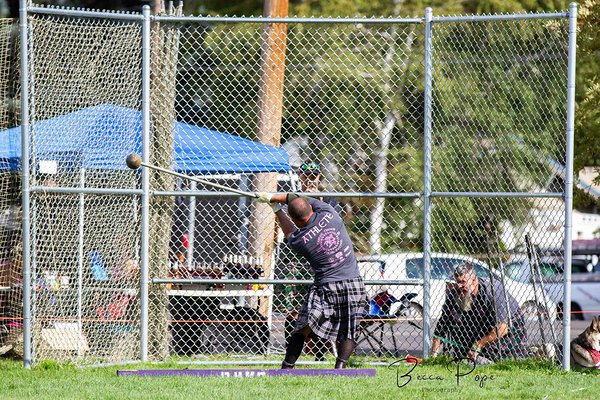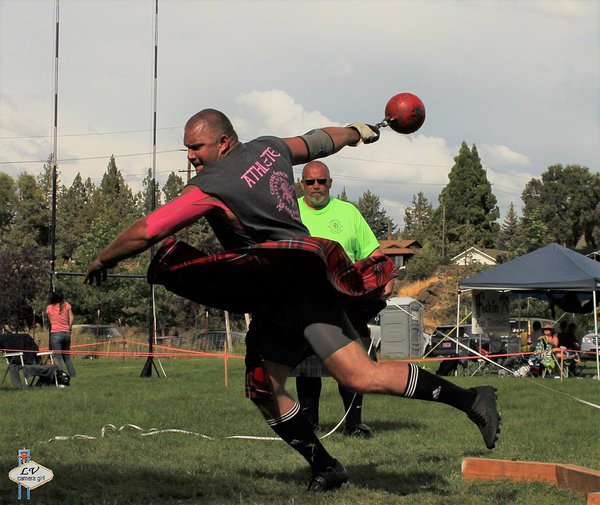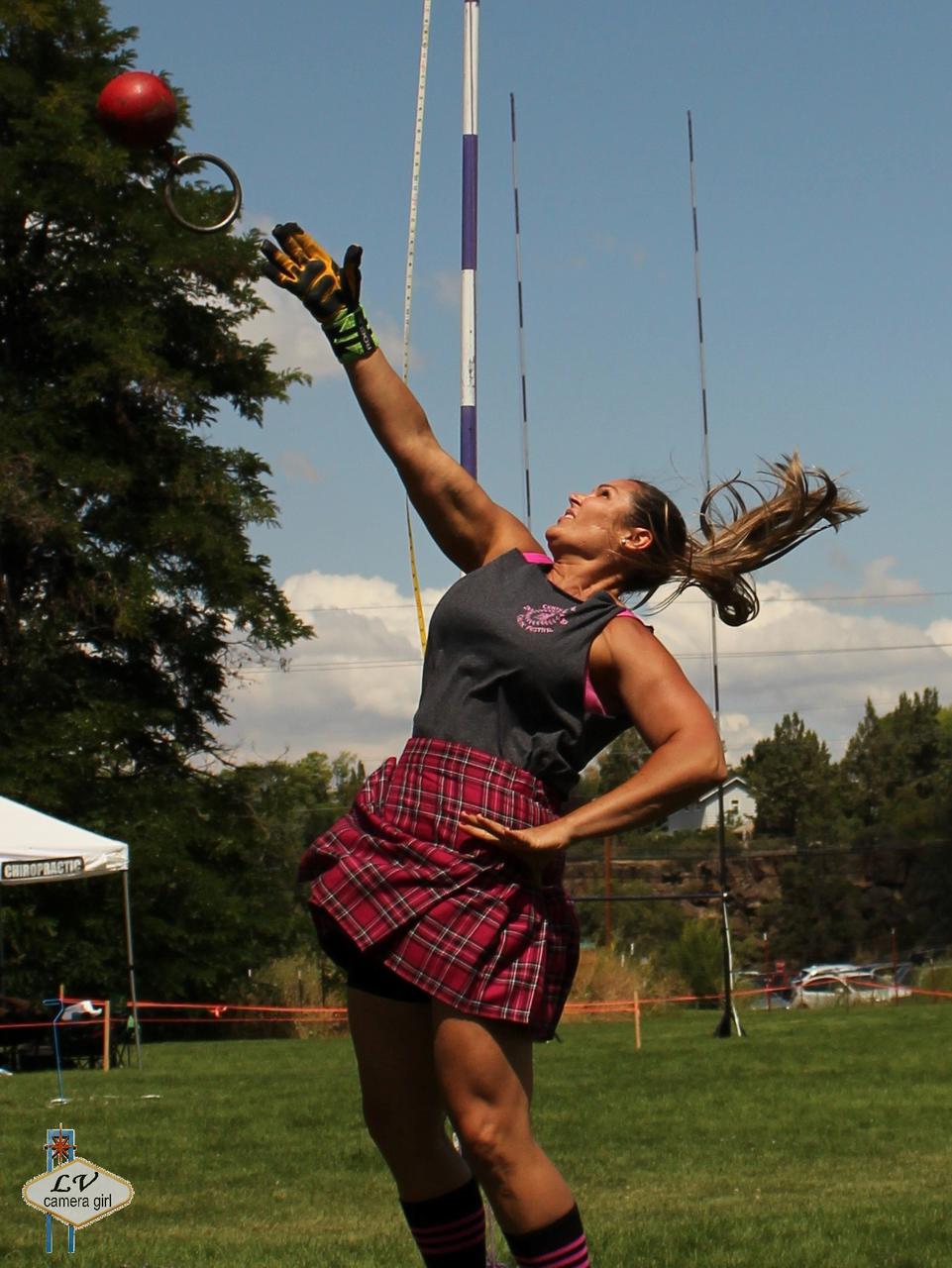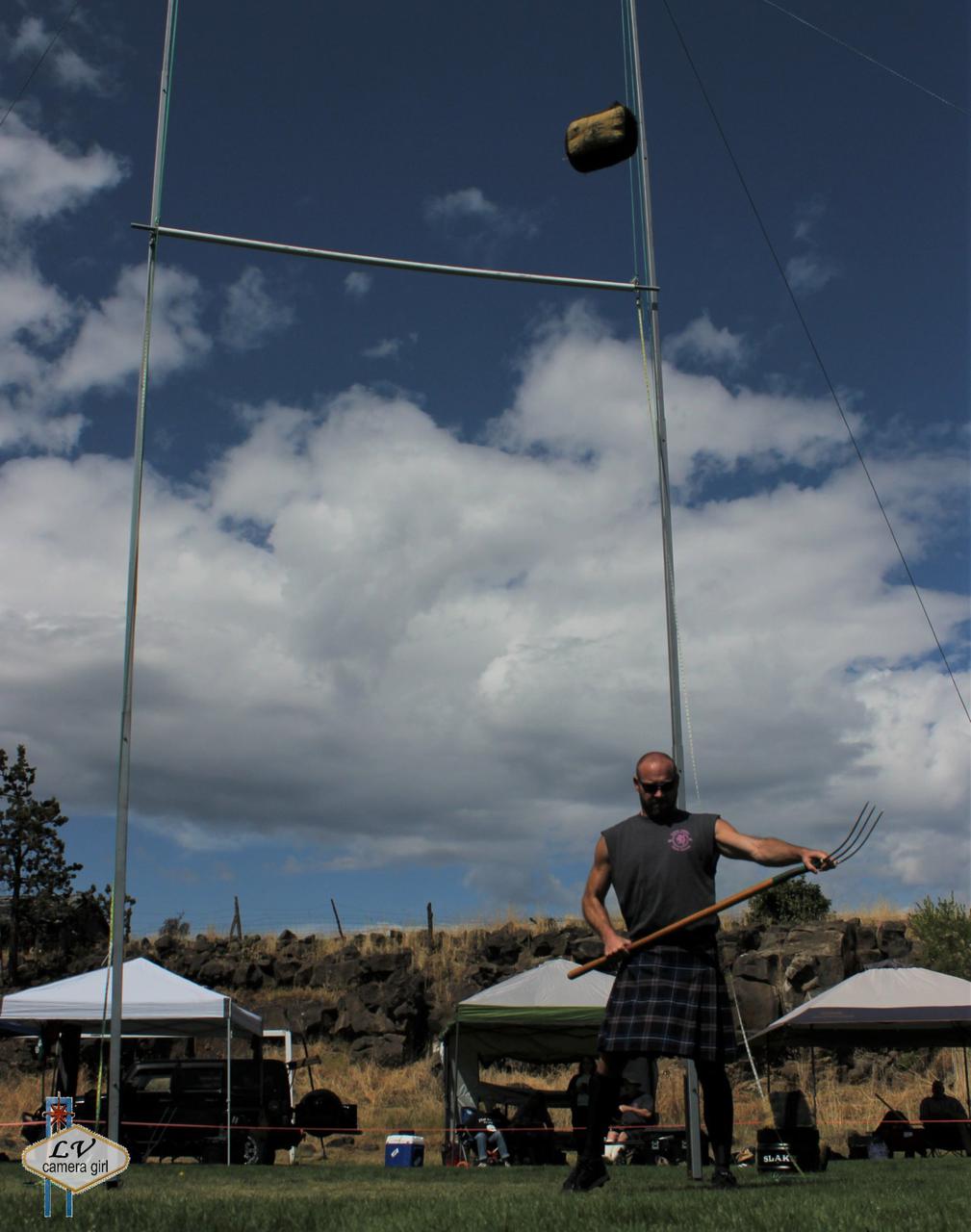HISTORY:
This event is similar to the modern-day shot put, as seen in the Olympic Games. Instead of a steel shot, a large stone of variable weight/shape is used. There are also some differences from the Olympic shot put in allowable techniques. There are two versions of the stone toss events, differing in allowable technique. The "Braemar Stone" uses a 20–26 lb stone for men and 13–18 lb for women, and does not allow for any forward motion toward the toeboard/trig to deliver the stone, i.e. it is a standing, or power position throw. You will often see athletes turn in place after the stone is released. This is allowed, as it does not propel them forward. In the "Open Stone" throw, the athlete uses a stone weighing 16–22 lb stone for men, or 8–12 lb for women. The thrower is allowed to use any throwing style they want, so long as the stone is tossed with one hand, and the stone is cradled in the neck until the moment it is released. Most athletes in the open stone event use either the glide, shuffle or spin technique, but a standing throw is still allowed.
SCOTTISH HAMMER THROW:
This event is similar to the hammer throw as seen in modern-day track and field competitions, though with some significant differences. In the Scottish event, there are two different hammers, a heavy and light. The hammer itself is a round metal ball that is attached to the end of a shaft about 4 feet in length, and made out of wood, bamboo, rattan, or most commonly in American, pvc/plastic. The weights for each are 22 lb and 16 lb for men, and 16 lb and 12 lb for women. With the feet in a fixed position, the hammer is whirled about one's head and thrown for distance over the shoulder. Hammer throwers sometimes use specially designed footwear with flat blades to dig into the turf to maintain their balance, and to resist the centrifugal forces of the implement as it is spun overhead. This substantially increases the distance attainable in the throw.
WEIGHT FOR DISTANCE (WFD):
WFD is separated into two individual events, Heavy WFD and Light WFD. Heavy WFD uses an implement weighing 56 lb for men, 42 lb for masters men, 28 lb for women and 21 lb for masters women. While Light WFD uses a 28 lb implement for all men, and 14 lb for all women. The weights are made of metal and have a handle attached, either directly or more commonly, by means of a chain. The implement is thrown using one hand only, but otherwise using any technique. Usually a spinning technique is employed. The longest throw in this event wins.
WEIGHT OVER BAR (WOB):
This event may also be referred to as weight for height. The athletes attempt to toss a weight, with an attached handle, over a horizontal bar using only one hand. Each athlete is allowed three attempts at each height. Successful clearance of the height allows the athlete to advance into the next round at a greater height. The competition is determined by the highest successful toss with fewest misses being used to break tie scores. The weights consist of 56 lb for men, 42 lb for master's men, 28 lb for women, and 21 lb for master's women.
SHEAF TOSS:
The sheaf bag, made of burlap and twine, is tossed vertically with a pitchfork over a raised bar. The bag will vary by the class of athletes, weighing 20 lb for the men, 16 lb for master's men, and 10 or 12 lb for the women's classes. The progression and scoring of this event is similar to that of Weight Over Bar. There is significant debate among athletes as to whether the sheaf toss is in fact an authentic Highland event, as it was not an event in the first Games. Some argue it is actually a country fair event, but all agree that it is a great crowd-pleaser.
The Highland Games may have originated in Ireland as early as 2000 BC and were brought to Scotland by the Scotti in the 4th and 5th centuries. However, some believe the roots of the Highland games date to the 11th century when the first official games was held. King Malcolm III needed a personal courier, so he called a foot race to the summit of Creag Chòinnich, near Braemar, in the hopes of finding the fastest runner. Many games still include a hill race, although the winner is no longer destined for a life of servitude!
The games evolved from impromptu competitions at clan assemblies to tests of strength, stamina, and creative skills to entertain clan chiefs, kings, and queens. Clan chiefs would use the games to evaluate their clansmen and assign them to the best jobs, and to test their clans against other clans. The games also included traditional Highland sports and "heavy events" like the hammer throw, tug-o-war, and caber toss.
Popularity grew until the Act of Proscription outlawed Scottish customs, dress, and gatherings in response to the Jacobite Rebellion in 1746. The games went into decline but became popular again after the Act was repealed in 1782. Today, similar athletic competitions are held around the world under the auspices of local Caledonian societies and are believed to follow traditional customs. Events at modern Highland Games may include caber toss, hammers, weight throws, stone toys, and sheaf toss (although not originally part of the games). Scottish dancing and herding dog trials can also be a part of the games, although we do not have them at our event currently.
CABER TOSS:
A long, slightly tapered log is stood upright, and hoisted, or "picked" by the athlete, who then balances it vertically.
Holding the smaller end in their hands, the competitor runs forward attempting to toss it in such a way that it turns end over end with the upper (larger) end striking the ground first. The smaller end that was originally held by the athlete then hits the ground in the 12 o'clock position, measured relative to the direction the athlete chose to run. If successful, the athlete is said to have "turned" the caber. Cabers can vary greatly in length, weight, taper and balance, all of which affect the degree of difficulty in making a successful toss. Athletes are judged on how closely their throws approximate the ideal 12 o'clock toss on an imaginary clock.
STONE THROW: CABER TOSS:
A long, slightly tapered log is stood upright, and hoisted, or "picked" by the athlete, who then balances it vertically.
Holding the smaller end in their hands, the competitor runs forward attempting to toss it in such a way that it turns end over end with the upper (larger) end striking the ground first. The smaller end that was originally held by the athlete then hits the ground in the 12 o'clock position, measured relative to the direction the athlete chose to run. If successful, the athlete is said to have "turned" the caber. Cabers can vary greatly in length, weight, taper and balance, all of which affect the degree of difficulty in making a successful toss. Athletes are judged on how closely their throws approximate the ideal 12 o'clock toss on an imaginary clock.
This event is similar to the modern-day shot put, as seen in the Olympic Games. Instead of a steel shot, a large stone of variable weight/shape is used. There are also some differences from the Olympic shot put in allowable techniques. There are two versions of the stone toss events, differing in allowable technique. The "Braemar Stone" uses a 20–26 lb stone for men and 13–18 lb for women, and does not allow for any forward motion toward the toeboard/trig to deliver the stone, i.e. it is a standing, or power position throw. You will often see athletes turn in place after the stone is released. This is allowed, as it does not propel them forward. In the "Open Stone" throw, the athlete uses a stone weighing 16–22 lb stone for men, or 8–12 lb for women. The thrower is allowed to use any throwing style they want, so long as the stone is tossed with one hand, and the stone is cradled in the neck until the moment it is released. Most athletes in the open stone event use either the glide, shuffle or spin technique, but a standing throw is still allowed.
SCOTTISH HAMMER THROW:
This event is similar to the hammer throw as seen in modern-day track and field competitions, though with some significant differences. In the Scottish event, there are two different hammers, a heavy and light. The hammer itself is a round metal ball that is attached to the end of a shaft about 4 feet in length, and made out of wood, bamboo, rattan, or most commonly in American, pvc/plastic. The weights for each are 22 lb and 16 lb for men, and 16 lb and 12 lb for women. With the feet in a fixed position, the hammer is whirled about one's head and thrown for distance over the shoulder. Hammer throwers sometimes use specially designed footwear with flat blades to dig into the turf to maintain their balance, and to resist the centrifugal forces of the implement as it is spun overhead. This substantially increases the distance attainable in the throw.
WEIGHT FOR DISTANCE (WFD):
WFD is separated into two individual events, Heavy WFD and Light WFD. Heavy WFD uses an implement weighing 56 lb for men, 42 lb for masters men, 28 lb for women and 21 lb for masters women. While Light WFD uses a 28 lb implement for all men, and 14 lb for all women. The weights are made of metal and have a handle attached, either directly or more commonly, by means of a chain. The implement is thrown using one hand only, but otherwise using any technique. Usually a spinning technique is employed. The longest throw in this event wins.
WEIGHT OVER BAR (WOB):
This event may also be referred to as weight for height. The athletes attempt to toss a weight, with an attached handle, over a horizontal bar using only one hand. Each athlete is allowed three attempts at each height. Successful clearance of the height allows the athlete to advance into the next round at a greater height. The competition is determined by the highest successful toss with fewest misses being used to break tie scores. The weights consist of 56 lb for men, 42 lb for master's men, 28 lb for women, and 21 lb for master's women.
SHEAF TOSS:
The sheaf bag, made of burlap and twine, is tossed vertically with a pitchfork over a raised bar. The bag will vary by the class of athletes, weighing 20 lb for the men, 16 lb for master's men, and 10 or 12 lb for the women's classes. The progression and scoring of this event is similar to that of Weight Over Bar. There is significant debate among athletes as to whether the sheaf toss is in fact an authentic Highland event, as it was not an event in the first Games. Some argue it is actually a country fair event, but all agree that it is a great crowd-pleaser.
